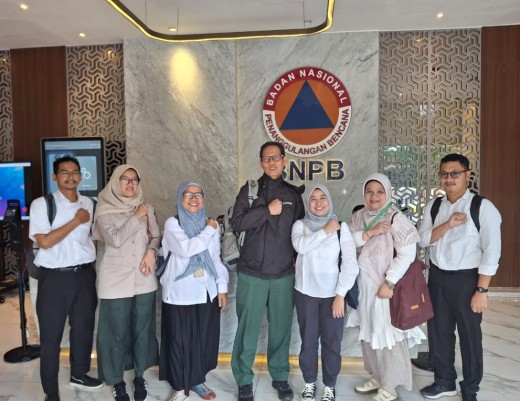FIKES UPNVJ - The teaching team for the Disaster Health Service Management Course, Public Health Study Program, Masters Program, National University of National Development "Veteran" Jakarta: Dr. Suparni, S.T., M.K.K.K, Dr. A.Joko Susanto, M.K.K.K; Dr. Putri Permatasari, M.Kes and Dr. Lusyta, M.Kes held a Field Visit to the National Disaster Management Agency (BNPB) Jakarta. This activity was held on Thursday, November 28, 2024, from 08.00-13.00 at BNPB Jakarta.

The National Disaster Management Agency (BNPB) is a national institution in Indonesia that is tasked with handling disasters that occur in Indonesia, both small and large scale. BNPB is also equipped with adequate Human Resources and infrastructure so that it can participate in disaster management in Indonesia. Achieving the competency of disaster management requires the readiness of health workers who are ready to respond in emergency situations.

Field visit learning activities to BNPB provide practical insight and in-depth understanding of how disaster management is carried out at the national level. Field visits are carried out by students of the Public Health Study Program. The Master's study program provides an opportunity to learn directly from practitioners and experts in their fields related to the role of BNPB in disaster management. The Disaster Health Service Management course in the Master's program aims to provide an in-depth understanding of health management and services in disaster situations. Field visits to BNPB can provide direct experience of how BNPB carries out its duties and responsibilities in disaster management and how disaster health service management is applied in the field.

The purpose of the visit to BNPB is for students to gain Practical Understanding: regarding the role and function of BNPB in disaster management. Students conduct Process Observations: Directly observing the disaster management process and health services carried out by BNPB. Discussion and Q&A activities regarding policies, strategies, and challenges in disaster management. And Practical Skills: Applying the theories that have been learned in real contexts and developing practical skills related to disaster health service management. The presentation of the material was delivered by Dr. Raditya Jati S.Si., M.Sc. as Deputy for Systems and Strategy of the National Disaster Management Agency (BNPB) regarding the Role of BNPB in Disaster Management and the Director of Disaster Risk Mapping and Evaluation of the National Disaster Management Agency (BNPB) Dr. Ir. Udrekh, S.E., M.Sc regarding the Role of Public Health in handling Non-Natural Disasters. At the beginning of the visit, students were given the opportunity to tour the Emergency Operational Center (EOC) room and the Diorama room for disaster management in Indonesia that had been carried out by BNPB.

Non-Natural Disasters such as the COVID-19 pandemic have also become a learning experience for BNPB, there is a concept of a method that discusses an Epidemic, namely a condition where the incidence of disease increases in a short time and its spread has covered a wide area. Then there is an Outbreak, namely the incidence of an infectious disease that increases significantly beyond the usual conditions at a certain time and area and can cause disaster. So literally in the context of potential disasters, Epidemics and Disease Outbreaks (EWP) are potential non-natural disaster threats caused by the occurrence of an infectious disease in an area within a certain period of time that can cause impacts (risks) of death and disruption of community activities. The method used in compiling the EWP hazard map is the scoring and weighting method for parameters based on sub-district administrative areas. The parameters used to compile the EWP hazard map are the density or prevalence of EWP hazards (based on nationally available data), namely: Malaria, Dengue Fever, Measles, Diphtheria and Hepatitis. Surveillance for Epidemic Disease Outbreaks is one of the roles of public health workers.
The role of Public Health in BNPB is to carry out disaster management, namely during pre-disaster, disaster, and post-disaster. Public Health must carry out preventive and promotive efforts. Examples of efforts that can be made: Preventive: Conducting education and training or disaster simulations in disaster-prone areas (eg: coastal areas) and carrying out disease prevention programs. Promotive: Conducting counseling.
Paying attention to environmental health aspects: Environmental sanitation planning, water sanitation management training, clean water purification, making emergency toilets, mitigating disaster-prone environments. Paying attention to occupational safety and health: Mitigation and planning in disaster-prone areas. And most importantly, many diseases such as dengue fever/tetanus/malaria arise after a disaster, causing many fatalities. So this needs to be addressed.